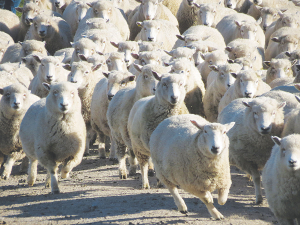Getting sheep shape at Pyramid Farm
The vineyards at Pyramid Farm in Marlborough’s Avon Valley have never been run of the mill, with plantings that follow the natural contours of the land, 250 metres above sea level.
 It is estimated that 2-10% of the national flock is affected by flystrike annually, costing millions in economic effects.
It is estimated that 2-10% of the national flock is affected by flystrike annually, costing millions in economic effects.
There is no “one-size fits all” approach when it comes to effective prevention and treatment of flystrike.
Instead, it relies on a multi-pronged approach.
Flystrike occurs when blowflies lay eggs in warm, moist areas on a sheep and these eggs hatch into maggots, which then invade the living sheep. During spring, summer and autumn – and especially when conditions are humid – flystrike can be a significant problem for New Zealand sheep farmers.
It is estimated that 2-10% of the national flock is affected by flystrike annually and the subsequent economic effects can be measured in the millions of dollars.
Farmers spend in excess of $15 million annually on sheep dips, alone.
Alongside the economic impacts of flystrike, there are obvious animal welfare issues.
There are four blowfly species cause flystrike in New Zealand.
In order of prevalence, they are:
1. Australian green blowfly (Lucilia Cuprina)
2. European green blowfly (Lucilia sericata)
3. Brown blowfly (Calliphora stygia)
4. Hairy maggot blowfly (Chrysomya rufifacies)
Insect growth regulators (IGRs) describe a broad mode of action, rather than a distinct chemical group. These chemicals affect the ability of immature insects to develop through to adulthood. There are two IGR chemical groups relevant to flystrike prevention:
1. Benzyl phenyl ureas (BPUs) – diflubenzuron and triflumuron
2. Triazine and pyrimidine derivatives – cyromazine and dicyclanil
Neonicotinoids are a relatively new chemical class of synthetic pesticides. There is only one neonicotinoid – imidacloprid – registered for use on sheep in New Zealand and it is available in combination with triflumuron.
Spinosyn Spinosyns are one of the newest chemical classes of insecticides and is a natural non-synthetic compound. The Spinosyn available for use in fly treatment is spinosad. Spinosyn is also available in combination with cyromazine as a saturation jetting formulation.
While resistance to chemicals is difficult to avoid altogether, strictly following the application instructions and using well-functioning gear to apply the chemicals can slow its foothold.
Regulation and safer alternative chemicals have seen the use and availability of organophosphates decrease in New Zealand. Only two active ingredients remain on the market:
1. Propetamphos – flystrike spot treatment and saturation dip available to approved handlers only, and
2. Diazinon – likely to be withdrawn from the sheep-dip market in the near future.
Tips to slow blowfly resistance:
• Only use chemicals known to be effective.
• If treating twice in a season, rotate effective chemical groups.
• Use a different chemical to treat an active flystrike lesion than used for flystrike prevention.
• If using combination sheep dips for flystrike prevention and lice control, consider the efficacy spectrum and resistance status of the products in the combination.
• If lice control in short wool and fly control in long wool is required in the one year, use products from different chemical groups.
Facts about blowflies
1. Only a small percentage of the overall fly population affect sheep.
2. These flies are almost always attracted to the breech area.
3. They have a seasonal activity pattern of onset and population increase, so treatments can be timed accordingly.
These three factors mean use of a preventive chemical product can be limited to a specific time, to the breech area, and on the most susceptible animals (e.g. lambs at or before weaning).
• Information gleaned from the Beef+LambNZ factsheet on flystrike; more next issue
Greenlea Premier Meats managing director Anthony (Tony) Egan says receiving the officer of the New Zealand Order of Merit (ONZM) honour has been humbling.
Waikato dairy farmer Neil Bateup, made a companion of the New Zealand Order of Merit (CNZM) in the New Year 2026 Honours list, says he’s grateful for the award.
Another Australian state has given the green light to virtual fencing, opening another market for Kiwi company Halter.
Farmer interest continues to grow as a Massey University research project to determine the benefits or otherwise of the self-shedding Wiltshire sheep is underway. The project is five years in and has two more years to go. It was done mainly in the light of low wool prices and the cost of shearing. Peter Burke recently went along to the annual field day held Massey's Riverside farm in the Wairarapa.
Applications are now open for the 2026 NZI Rural Women Business Awards, set to be held at Parliament on 23 July.
Ravensdown has announced a collaboration with Kiwi icon, Footrot Flats in an effort to bring humour, heart, and connection to the forefront of the farming sector.

OPINION: The release of the Natural Environment Bill and Planning Bill to replace the Resource Management Act is a red-letter day…
OPINION: Federated Farmers has launched a new campaign, swapping ‘The Twelve Days of Christmas’ for ‘The Twelve Pests of Christmas’ to…